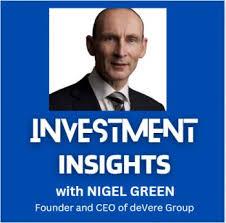
Markets In A Post-Modern Era: New Reality Investors Face - Arabian Post
Markets are sending urgent signals.
Gold has burst above $3,600 an ounce, a record that reflects both anticipation of rate cuts and a broader scramble for safety. Treasury yields have swung sharply, with shorter maturities pulled lower by expectations of central bank easing while long-dated bonds creep toward multi-year highs, and across equities, momentum has become fragmented, with volatility rising around political headlines and economic uncertainty.
These are not isolated moves. They are symptoms of a deeper shift in the market environment.
The long era defined by relentless disinflation, falling interest rates, and abundant liquidity is behind us. What's emerging is what many analysts are now calling a 'post-modern; market cycle.
It's an era defined by debt burdens that are historically high, demographic shifts that strain fiscal systems, the unwinding of globalization, and an inflationary undertone that refuses to disappear.
This changing backdrop means the forces that powered portfolios over the past two decades cannot be relied upon to do the same in the next.
The safe assumption that central banks will always provide a backstop is giving way to a more unstable equilibrium where policymakers are constrained by debt, politics, and credibility. Investors are already responding to this recalibration by seeking havens and shortening horizons.
The surge in gold is a prime example. It is not simply a hedge against inflation but a hedge against systemic uncertainty.
Bond markets are another barometer. In the United States, the United Kingdom, and now increasingly across Europe, long-term yields are grinding higher not because growth expectations are roaring but because demand for government debt is thinning.
Central banks are no longer hoovering up supply, while pension funds and institutional buyers are hesitant to lock in decades of exposure to uncertain fiscal trajectories. This repricing has profound consequences.
See also Rate cut expectations drive markets to new highsWhen the backbone of the financial system demands higher compensation, the cost of capital rises everywhere. That shift reshapes equity valuations, real estate financing, and corporate borrowing strategies.
Equities remain caught between optimism over monetary easing and realism about slowing growth. Rate cuts may come, but they will not replicate the past. When inflation proves sticky, cuts are modest and temporary, and the floor under borrowing costs rises.
This creates a choppier environment where sector leadership is more contested and where sentiment swings quickly with each new data release or policy signal. The result is markets that feel less predictable and more headline-driven.
For Europe, this transition is especially stark. Political instability in France, with the Bayrou government fighting for survival in a confidence vote, has pushed French yields higher and reminded investors of the fragility in one of the eurozone's core economies.
At the same time, the European Central Bank (ECB) is under pressure to juggle conflicting priorities: anchoring inflation expectations, maintaining financial stability, and navigating divergent economic performance across member states. The euro, already volatile, has been sliding as traders reassess risk premiums in a bloc where fiscal cohesion is strained.
The interplay of these forces suggests we are in the early stages of a structural market evolution. Safe havens such as gold will command higher strategic weight as uncertainty becomes the norm rather than the exception. Sovereign debt markets will be more volatile, reflecting both supply dynamics and questions of political credibility.
Currencies will be more sensitive to domestic instability, especially in economies where fiscal discipline and growth prospects are in doubt.
See also Wall Street's jitters highlight case for global diversificationThe challenge for investor is not simply surviving volatility but understanding its causes. The post-modern cycle is not a temporary phase. It reflects the hard realities of aging populations, ballooning deficits, geopolitical fragmentation, and inflation that central banks cannot permanently suppress.
These realities are colliding with markets that had grown accustomed to a very different set of assumptions. This collision is why gold is at records, why bonds are demanding higher yields, and why currencies are under strain.
The urgency now lies in recognising that markets are operating under new rules. The comfortable patterns of the past-falling rates, reliable central bank support, and predictable disinflation-have been replaced by a messier, more unstable order.
This doesn't spell the end of opportunity, by any means, but it should mark the end of complacency.
Investors who misinterpret today's signals as temporary noise risk being wrong-footed. Those who accept that the environment itself has changed and who seek advice will be better position to grasp what comes next.
We're standing at the edge of a new market epoch. Gold's surge, bond market tensions, and political shocks in Europe are not disparate stories. They're chapters of the same book. The task now is to read that book with clarity.
The post-modern market is here, and it is rewriting the rhythm of global finance.
Nigel Green is deVere CEO and Founder
Also published on Medium .
Notice an issue? Arabian Post strives to deliver the most accurate and reliable information to its readers. If you believe you have identified an error or inconsistency in this article, please don't hesitate to contact our editorial team at editor[at]thearabianpost[dot]com . We are committed to promptly addressing any concerns and ensuring the highest level of journalistic integrity. Legal Disclaimer:
MENAFN provides the
information “as is” without warranty of any kind. We do not accept
any responsibility or liability for the accuracy, content, images,
videos, licenses, completeness, legality, or reliability of the information
contained in this article. If you have any complaints or copyright
issues related to this article, kindly contact the provider above.


















Comments
No comment